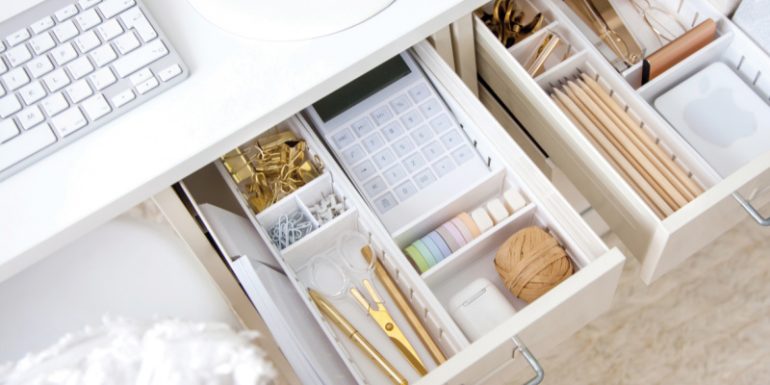By Amanda N. Wegner
Spring is a time of new beginnings, which is why it’s also a time for cleaning house and getting organized. “The start of a new year, springtime or simply entering better weather, people have a new energy in them that sparks an interest in creating new habits and beginning new projects,” says Shauna Opitz, owner of the organizational service SO Organized out of Twin Lakes. “This is why many people plan to start their cleaning projects around those times.”
It’s also a good time to give your home a deep clean to clear out the dust, drab and accumulated piles that come with being cooped up indoors through the winter months, letting go of all the associated stress. “Spring is one of our busiest times of the year because the cleanings booked are typically deep cleans,” says Leah Egger, owner of North Shore Cleaning in Delavan. “They are essentially a fresh start on your home.”
To help you give your home a spring refresh, we’ve asked three local cleaning and organizing professionals for their insight and pro tips.
START ON THE RIGHT FOOT
Barbara Schuld Adams is a licensed interior designer and the founder of Lake Geneva’s Interior Concept Design. Before you start organizing your space, she says, you have to organize your mind. “If you organize your mind and envision what your tasks are, this helps you accomplish what you need to do without becoming overwhelmed, and prevents you from not knowing where to start,” she explains. “It allows you to set your priorities.”
With your mind organized, it’s time to create a plan of attack by deciding which spaces you’re going to tackle.
Egger suggests starting in your most problematic areas, which for many people includes the kitchen, pantry, garage, basement or home office space.
Once you’ve started the cleaning and organizing process, Opitz recommends using the tried-and-true, three-pile approach: one pile each for things you want to keep, donate and toss. She suggests it’s best to remove the “donate” and “trash” piles from your space as soon as you can.
Because there’s no one way to organize a space, there are three tenets to bear in mind: First, keep like with like; this applies in every space. When you’re cooking, all of the spices should be together, for example. Second, place your most frequently used items in easily accessible and logical places. And third, create a system and stick to the system in order to prevent the disorganization from returning. Or, in other words: “Make your space work for you, not the other way around,” says Opitz.
While some people take great joy in getting rid of stuff, it can be a challenge for others. If that is the case for you, Schuld Adams suggests a fourth pile: “Maybe,” which you’ll decide on later. “The ‘Maybes’ are things you’re not ready to let go,” suggests Schuld Adams. “Put them aside in a container and revisit in a week or month. You might find you love it, but you don’t need it. Sometimes small steps in a process are a little easier than giant steps.”
To make the most of each space in your home, consider these tips:
Garage: Garage spaces benefit from seasonal rotation. Move the tools and gear for the new season to the most accessible place in the garage and relocate or store past seasons’ items, suggests Opitz. In addition, Egger recommends investing in racks for shovels, brooms and rakes to get them off the ground. If you keep tools in your garage space, try using wire shelving units and peg boards to organize similar tools together.
Pantry: According to Schuld Adams, the first step in the pantry is to remove everything and thoroughly clean the shelves. Then, as you put items back in the pantry, Opitz offers two options for organizing. One is to organize by meal; place all breakfast items on one shelf and lunch items on another, for instance. The second option is to organize your pantry like the aisles of a grocery store with similar items together: canned veggies and beans beside pastas, sauces, cereals, snacks, etc.
Egger recommends going through your pantry every few months. If you haven’t used things, consider donating them to clear space. Depending on your pantry space, you may want to use baskets for noodles, soup cans, mashed potatoes and canned veggies, which are easy to pull out to find what you’re looking for. Use clear containers for anything at eye level or higher. To keep the pantry space clean, try to get in the habit of wiping down containers as you return them to the pantry.
Basement: Most basement organizing involves tackling the unfinished or storage portion of the basement, which can contain a treasure trove of items in boxes and bins, both remembered and forgotten.
The key to organizing the basement, says Opitz, is consistency in containers. “Having a number of different containers from different companies is a bad idea when storing items such as holiday decorations or out-of-season clothing,” she says. She suggests using a single brand of container for each category of items you are storing. The benefit is that within a brand, there may be several different options and sizes, but they are often made to fit together and stack properly.
Also, utilize your vertical space, notes Egger. Either use clear containers so you can see into each one, or use a different colored container for each category you are storing. “To get the most of your basement, I cannot stress this enough — shelves and labeled totes!” she says. “Utilize that upward space. Not only will it be a lifesaver in the event of your basement flooding, but you will maximize space.” She adds that when stacking containers on top of each other, remember to put the heaviest at the bottom and lightest on top.
Home office: The home office is often the most important space in need of organization as it is where bills are paid and important documents are retained. “It is key to be very methodical in this space,” says Opitz.
To store and organize important papers, develop a filing system that is well labeled and color-coded — this may involve either a label maker or one person’s clean handwriting. Color, notes Opitz, helps draw the eye to a particular category much quicker than a label alone can. The goal should be to organize your files in a way that, should something happen to you, others would easily be able to pick up where you left off. Keep regularly used items such as scissors, pens, etc., in easy- to-reach places or drawers. Similarly, place items that aren’t frequently used further away or in lower spaces not often accessed.
Kitchen: The kitchen is a space that has to work for your specific lifestyle. If you don’t cook often, place cookware low in cupboards or high on shelves out of reach. If you are an avid home chef, place those items in places that are easy to access. Do the same with bakeware. When organizing cupboards, try putting daily dishware near the dishwasher or sink so you don’t have to cross the kitchen to put them away, and place potholders near the stove.
When it comes to cleaning the kitchen, you should be deep-cleaning your appliances from time to time, no matter how often you use them. Do the same with cabinets, inside and out, says Egger. She also suggests putting a lemon or orange peel down the garbage disposal to clean it, and points out that half a lemon rubbed on stainless steel will also clean hard-water stains.
Declutter the counter as much as possible, recommends Schuld Adams. When cooking, try to rinse and put dishes in the dishwasher as quickly as possible. This reduces clutter, is visually nicer and helps you feel less overwhelmed. “The counter is one of the first things you see in the morning, and if its cluttered, it starts your day with a more cluttered emotional feeling.” Instead, consider adding an element of delight with fresh flowers, a plant or small lamps.
PROFESSIONAL ASSISTANCE
Spring cleaning, organizing, decluttering and downsizing can be daunting tasks, and the help of a professional can help lighten the load and reduce some of the stress these activities can bring.
“Sometimes we just need not only a knowledgeable professional, but a new friend who can work alongside you — someone who isn’t biased and genuinely wants to help you succeed in an area that may not come easily to you,” says Opitz.
Not only can these activities be physically and mentally tiring, but the process can stir up emotions as well. “Working with a professional makes it less daunting with a second set of hands,” says Schuld Adams. “It helps you see the forest through the trees, and we provide an extra set of hands that are removed emotionally and can help you get to what you want to accomplish.”
THINGS TO REMEMBER
- One of the tricks to staying organized throughout the year is to develop easily followed systems that are accessible to everyone in your household. Dedicated storage space in an entryway or mudroom for items like winter coats and boots, spring rain wear or summer beach gear will help keep these spaces organized year- round. Try adding shelving, hooks, baskets and cubbies personalized for the needs of each person in the home.
- For maximum spring cleaning, a home’s laundry and washing facilities can be utilized to clean rarely washed elements like slipcovers, drapes, throw rugs or fabric shower curtains.
- To make laundry day easier, try implementing a sorting system for lights, darks, whites and bedding with hampers designated for each.
- The key to effective closet storage is to ensure that everything is easily visible and accessible. This can mean paring down and donating clothes you no longer wear; hanging shirts, pants and dresses on uniform hangers for equal distribution; and maximizing overhead space for larger accessories.
- For those with large or walk-in closets, a portion of the storage space can be devoted to jewelry and hat storage. These storage solutions may include vertical hanging storage, specialized shelving or shallow drawers with jewelry storage insets.
- A good closet storage system should include space for shoes. This can involve dedicated shelving, shoe racks or hanging shoe storage. Keep pairs of shoes together and spaced far enough apart that you can easily see your options.
- One way to ensure peak kitchen organization is to dedicate a portion of the pantry storage to the creation of a “coffee nook” to store things like mugs, French presses, coffee accessories and even an automatic coffeemaker.
- To keep the kitchen cupboards and shelves organized, store like with like: mixing bowls, bakeware, food storage, everyday dishes and drinkware should each have their own storage space optimized for their shape.
- To make use of hard-to-reach or awkwardly placed cabinets, try vertical storage separators, or assign that space to rarely used or seasonal items.
- Even kitchen drawers need a good spring cleaning. Take drawer organization to the next level with the addition of drawer separators for flatware, cookware and knives.
- Pull-out organization solutions like spice rack pull-outs, bakeware pull-outs or garbage/recycle pull- outs can free up storage space in the kitchen’s prime real estate.
More Cleaning/Organizing Tips
Take your organization to the next level
- Don’t overlook the junk drawer and other “chaotic” areas.
- Every few months, go through your clothes, coats and shoes. If you haven’t worn things, consider donating them.
- Try to keep as much off the floor as possible. It will help the home look and feel better.
- A few times each year, clean the fans, vents/registers, windowsills, floorboards, cabinet tops, tops of appliances and light fixtures — these can accumulate a lot of dust, especially in homes with pets.





